Electronic tickets
HELP E-TICKET ISSUE or H/ETKT
To check airline specifications for e-tickets, refer to the MyTravelport knowledge base:
E-ticketing functionality information for all participating Travelport airlines or type ETKT XX (XX = carrier code) in the MyTravelport search bar for information of an individual carrier.
This topic covers:
-
Requirements for e-tickets
-
Issuing the e-ticket from graphical view, from terminal views, and for specific passengers/filed fares
-
Specific document type production
-
Post-ticketing effects in the booking file
-
Electronic ticket record
Requirements for electronic tickets
You can issue an electronic ticket for those airlines that participate in electronic ticketing in the GDS, provided that the booking is eligible for electronic ticketing. Below are some of the requirements that must be met for the successful production of e-tickets:
-
The carrier must be an e-ticketing participant.
-
The flight segments must be e-ticket eligible (should have E indicator).
-
If there are multiple carriers in the booking file, the interline agreement must be verified.
-
Positive acknowledgment from each carrier is required.
-
The form of payment must be accepted for e-ticketing by the carrier.
-
The passenger type code (PTC) must be accepted for e-ticketing by the carrier.
-
The travel agency must be within carrier’s e-ticketing points of sale.
-
The secure flight SSR must be present when required.
-
Additional requirements may be applicable, depending on the carrier.
To determine whether the current itinerary is eligible for e-ticketing, enter: DT/ETE0

Validate the booking before issuance
It is possible to verify if the minimum requirements for ticketing are present in the booking, using the following entries:
|
Format |
Explanation |
|---|---|
|
TKPVB |
Check for all filed fares |
|
TKP1VB |
Check for filed fare 1 |
|
TKP1P2VB |
Check for filed fare 1, passenger 2 only |
Note: If the form of payment is already added, either in the FOP or stored in the T line of the filed fare (TMU), the exact OB fees that will be collected can be displayed before ticketing using the TKPVB entries.

Issuing the electronic ticket
Issue tickets from the graphical view
-
Retrieve the booking.
-
If you have a form of payment already in the booking file, then it populates as masked in the Booking information section.
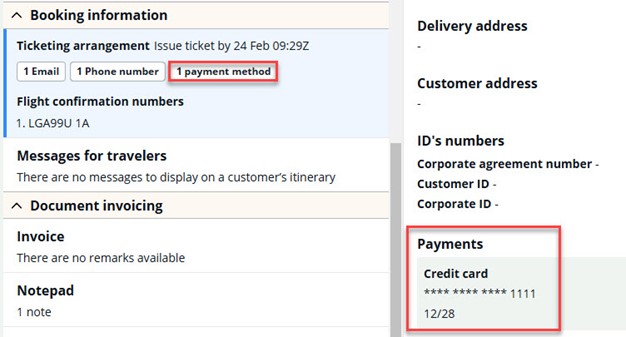
-
Select the Reservations section and press the Issue Ticket button. The Review and Confirm screen is displayed.
Important: In this screen it is possible to add or modify the Payment Method using the drop-down menu under Payments
Screen when there is no payment information:

Note: Easy Pay is an option when you open the Payment drop-down menu and select Credit Card.
For traditional bookings, you can also add or edit some ticketing details prior to issuing the ticket.
-
For commission, select whether it is a percentage or amount, then enter a value.
-
Endorsements
-
For IT/BT fare type, select whether it is an Inclusive tour (IT) or Bulk tour (BT). Default is None.
-
Tour code
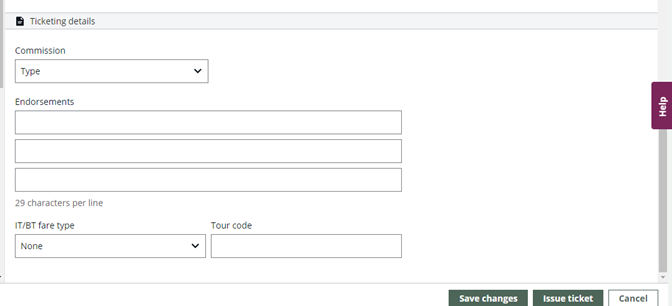
To issue, select the Issue Ticket button.
Note: If you have just added or modified the payment method, select Save Changes.
A confirmation message is displayed.

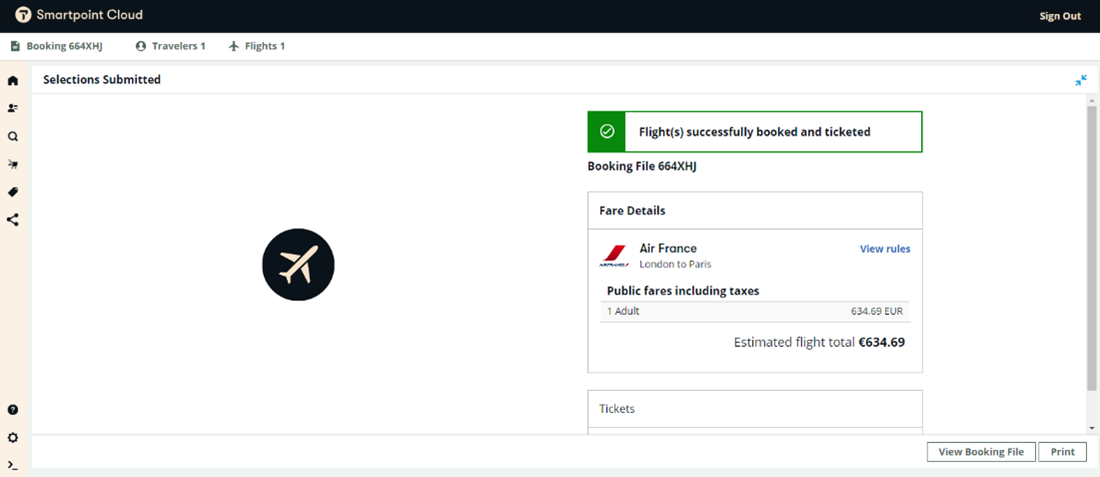
Upon ticketing, all passenger ticket information is displayed. Select the Reservations section and scroll down to view the e-ticket numbers.
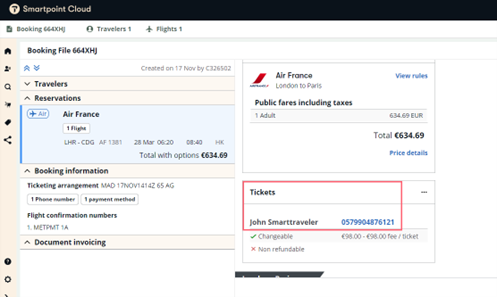
Note: From the graphical view, it is currently not possible to issue tickets based on passenger and/or filed fares selection.
Issue tickets from the terminal view
To issue all documents, including an electronic ticket, enter: TKP (TicKet Please). This entry will end the booking file and issue the e-ticket and any associated documents including itineraries and MIRs.
Once issued, the following alert appears. If the default ticketing type is e-ticket for the airlines booked, an e-ticket will automatically be generated.

Issue tickets for specific passengers/filed fares
The ticket command TKP assumes that tickets are required for all passengers and all filed fares. However, from the terminal view it is possible to identify a specific passenger and/or a specific filed fare for ticketing.
It is usually more efficient to make the passenger selection at the time of the fare request, often paired with a segment selection, and this will determine which passengers and/or segments will be produced at the time of ticketing.
The entry TKP will issue tickets for all passengers in the booking file, irrespective of the number or type of passengers or different fare quotes. Each passenger is automatically linked to a fare quote.
If the filed fare is for all the passengers in the booking file, but you only wish to issue tickets for some of them, use the following entries.
-
TKP1P1 issues ticket for filed fare 1 passenger 1. When specifying a passenger, it is also necessary to specify the filed fare.
-
TKP2 issues tickets for all passengers for filed fare 2. When there are multiple passengers on one filed fare, all passengers will be issued for that filed fare if no passenger number is specified.
Additional formats
|
Format |
Explanation |
|---|---|
|
TKP3 |
Ticket for filed fare 3 only |
|
TKP1P3 |
Ticket for filed fare 1 passenger 3 |
|
TKP1P3-5 |
Ticket for filed fare 1 passenger 3 through to 5 |
|
TKP2P2.4 |
Ticket for filed fare 2 passengers 2 and 4 only |
Specific document type production
MyTravelport search: Travelport+ Formats Guide for Document Production
You can use ticketing entries to specify the device to which you transmit ticketing/document information. For example, you may just need to print an itinerary.
The following table lists commonly used device modifiers and formats.
|
To issue |
Use this format |
|---|---|
|
Itinerary/invoice only |
TKPDID |
|
Accounting data only |
TKPDAD |
|
Itinerary/invoice and accounting data |
TKPDIDAD |
|
Ticket only |
TKPDTD |
|
Ticket and accounting data |
TKPDTDAD |
Post-ticketing effects in the Booking file
When the ticket is issued, the Booking file is automatically updated.
-
Ticket Field is amended to add the date/time of issue together with the agent's sign on and duty code.
Graphical view:
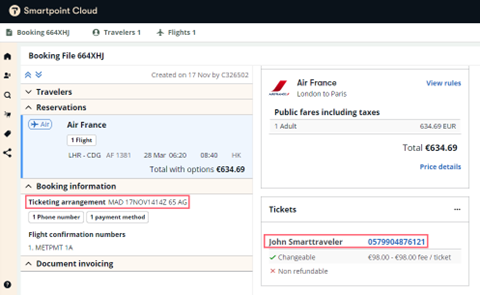
Click on the ticket number to see the Ticket Details, such as fare basis code, form of payment, coupon status, and endorsements.

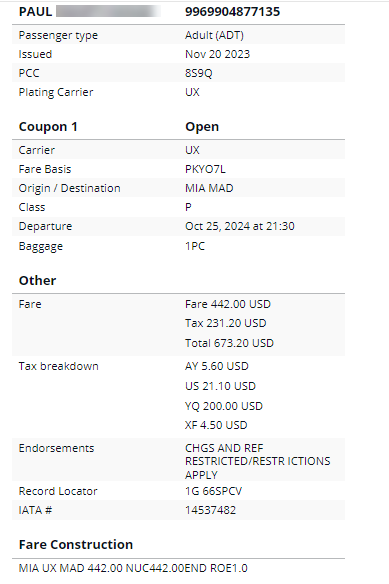
Terminal view:
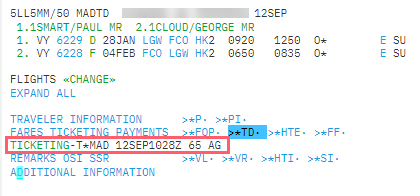
-
Filed fares field is updated to show the ticket number
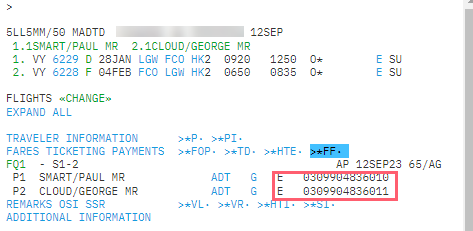
-
Tins Remarks field displays the ticket number, currency and total fare.
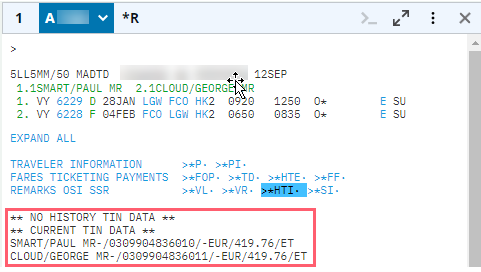
-
HTE field stores the electronic tickets records.
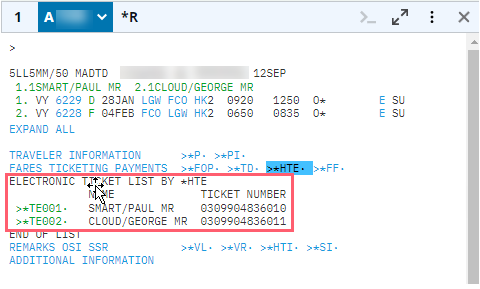
Electronic ticket record
MyTravelport search: Travelport+ Formats Guide for Document Production
Graphical view
Click on the GDS ticket number link to display ticketing details, such as fare basis code, form of payment, coupon status, and endorsements.


Terminal view
When you select *HTE, the electronic ticket record is displayed.
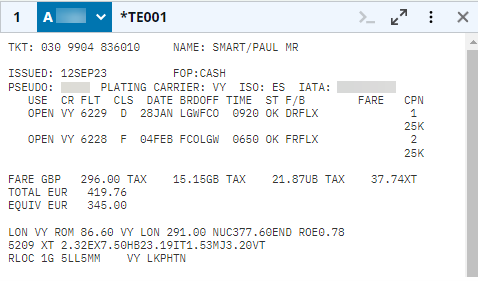
When you issue an electronic ticket, an image of the ticket is stored in the carrier’s database. This image is referred to as an Electronic Ticket Record (ETR).
The booking file is not linked to the electronic ticket record. Any updates to the booking file do not affect the ticket record.
The following are the coupons status indicators that you will see in an ETR.
-
ARPT - Airport Carrier controlled (unused, exchanges, and refunds are allowed by most carriers)
-
CKIN - Passenger has checked in with the operating carrier (most carriers do not allow exchanges/refunds)
-
CLSD - Closed
-
EXCH - Coupon has been exchanged
-
LFTD - Passenger has boarded the aircraft
-
OPEN - Open for use
-
PRTD - Printed by carrier (converted from electronic record to a paper document)
-
RFND - Coupon has been refunded
-
SUSP - Restricted use by validating carrier
-
USED - Passenger has flown
-
UNVL - Made unavailable for use by validating carrier - can only be exchanged
-
VOID - Ticket voided
Display electronic ticket record
You can display an e-ticket from a displayed booking file, by the e-ticket number or other means.
To access the ETR from the booking file, display the booking file, type *HTE and press Enter or click on *HTE.
If there is more than one ticket in the PNR, a list of ticket numbers will be displayed.
To access the ETR by e-ticket number, without the booking file being displayed, type *TE/ followed by the ticket number (13 digits) and press Enter.
Example: *TE/ 0309904836010
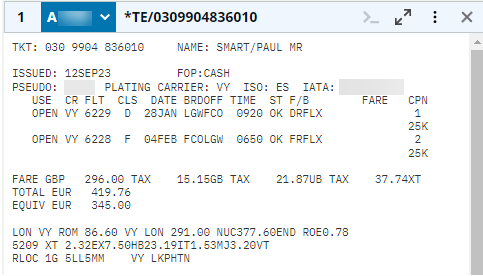
The following table lists formats to view an Electronic Ticket Record.
|
To view the Electronic Ticket Record |
Use this format |
|---|---|
|
From an active booking file |
*HTE |
|
By ticket number |
*TE/0141667436821 |
|
Display e-ticket record held in the American Airlines database using the passenger's mileage membership number |
*TE/AA/FF10087654 |
|
Display e-ticket record held in the Deutsche Lufthansa database using the credit card number |
*TE/LH/CC37XXXXXXXXXXX |
|
Retrieve an e-ticket record from the Air France database using the date, routing, and passenger family name |
*TE/AF/10APR08PARMRS-LEBLANC |
Display electronic ticket record history
If the carrier allows it, an Electronic Ticket Record History can be displayed. It is helpful if you need to verify the ticket number on the first screen or track any changes that were made to the ticket.
To display ETR history, enter: *TEH
Retransmit electronic ticket support documents
To reprint support documents, enter the ticket number: TSD1259900191818
To reprint only agent coupon: TSD9329900543209*AGT
To reprint only electronic ticket receipt: TSD9329900543209*ETR